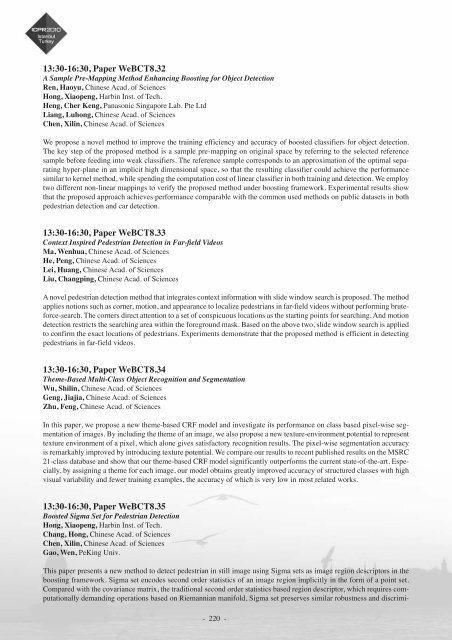Abstract book (pdf) - ICPR 2010
Abstract book (pdf) - ICPR 2010
Abstract book (pdf) - ICPR 2010
- TAGS
- abstract
- icpr
- icpr2010.org
Create successful ePaper yourself
Turn your PDF publications into a flip-book with our unique Google optimized e-Paper software.
13:30-16:30, Paper WeBCT8.32<br />
A Sample Pre-Mapping Method Enhancing Boosting for Object Detection<br />
Ren, Haoyu, Chinese Acad. of Sciences<br />
Hong, Xiaopeng, Harbin Inst. of Tech.<br />
Heng, Cher Keng, Panasonic Singapore Lab. Pte Ltd<br />
Liang, Luhong, Chinese Acad. of Sciences<br />
Chen, Xilin, Chinese Acad. of Sciences<br />
We propose a novel method to improve the training efficiency and accuracy of boosted classifiers for object detection.<br />
The key step of the proposed method is a sample pre-mapping on original space by referring to the selected reference<br />
sample before feeding into weak classifiers. The reference sample corresponds to an approximation of the optimal separating<br />
hyper-plane in an implicit high dimensional space, so that the resulting classifier could achieve the performance<br />
similar to kernel method, while spending the computation cost of linear classifier in both training and detection. We employ<br />
two different non-linear mappings to verify the proposed method under boosting framework. Experimental results show<br />
that the proposed approach achieves performance comparable with the common used methods on public datasets in both<br />
pedestrian detection and car detection.<br />
13:30-16:30, Paper WeBCT8.33<br />
Context Inspired Pedestrian Detection in Far-field Videos<br />
Ma, Wenhua, Chinese Acad. of Sciences<br />
He, Peng, Chinese Acad. of Sciences<br />
Lei, Huang, Chinese Acad. of Sciences<br />
Liu, Changping, Chinese Acad. of Sciences<br />
A novel pedestrian detection method that integrates context information with slide window search is proposed. The method<br />
applies notions such as corner, motion, and appearance to localize pedestrians in far-field videos without performing bruteforce-search.<br />
The corners direct attention to a set of conspicuous locations as the starting points for searching. And motion<br />
detection restricts the searching area within the foreground mask. Based on the above two, slide window search is applied<br />
to confirm the exact locations of pedestrians. Experiments demonstrate that the proposed method is efficient in detecting<br />
pedestrians in far-field videos.<br />
13:30-16:30, Paper WeBCT8.34<br />
Theme-Based Multi-Class Object Recognition and Segmentation<br />
Wu, Shilin, Chinese Acad. of Sciences<br />
Geng, Jiajia, Chinese Acad. of Sciences<br />
Zhu, Feng, Chinese Acad. of Sciences<br />
In this paper, we propose a new theme-based CRF model and investigate its performance on class based pixel-wise segmentation<br />
of images. By including the theme of an image, we also propose a new texture-environment potential to represent<br />
texture environment of a pixel, which alone gives satisfactory recognition results. The pixel-wise segmentation accuracy<br />
is remarkably improved by introducing texture potential. We compare our results to recent published results on the MSRC<br />
21-class database and show that our theme-based CRF model significantly outperforms the current state-of-the-art. Especially,<br />
by assigning a theme for each image, our model obtains greatly improved accuracy of structured classes with high<br />
visual variability and fewer training examples, the accuracy of which is very low in most related works.<br />
13:30-16:30, Paper WeBCT8.35<br />
Boosted Sigma Set for Pedestrian Detection<br />
Hong, Xiaopeng, Harbin Inst. of Tech.<br />
Chang, Hong, Chinese Acad. of Sciences<br />
Chen, Xilin, Chinese Acad. of Sciences<br />
Gao, Wen, PeKing Univ.<br />
This paper presents a new method to detect pedestrian in still image using Sigma sets as image region descriptors in the<br />
boosting framework. Sigma set encodes second order statistics of an image region implicitly in the form of a point set.<br />
Compared with the covariance matrix, the traditional second order statistics based region descriptor, which requires computationally<br />
demanding operations based on Riemannian manifold, Sigma set preserves similar robustness and discrimi-<br />
- 220 -



